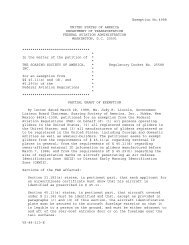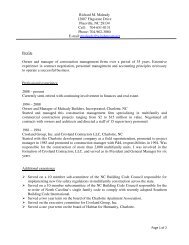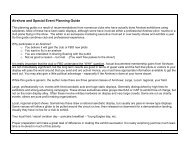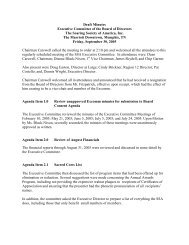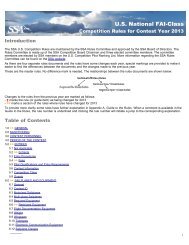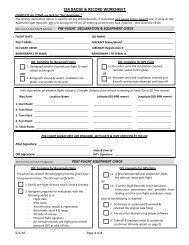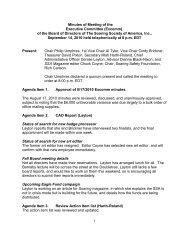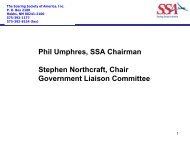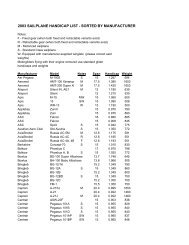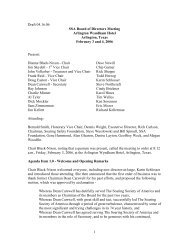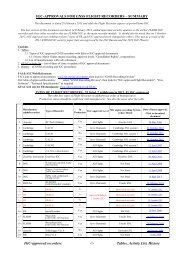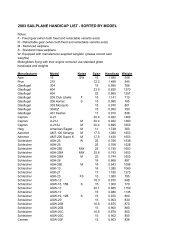1960 World Gliding Championships - Soaring Society of America
1960 World Gliding Championships - Soaring Society of America
1960 World Gliding Championships - Soaring Society of America
Create successful ePaper yourself
Turn your PDF publications into a flip-book with our unique Google optimized e-Paper software.
Disclaimer: This article was scanned<br />
from the original issue <strong>of</strong> <strong>Soaring</strong><br />
Magazine and captured into the Adobe<br />
PDF format. This process can result in<br />
subtle differences between the original<br />
and electronic formats. In almost all<br />
cases misspellings, odd punctuation<br />
are a result <strong>of</strong> the scanning process not<br />
the original author or publisher.<br />
Copyright 2001 <strong>Soaring</strong> <strong>Society</strong> <strong>of</strong><br />
<strong>America</strong>. Use without permission is<br />
prohibited.
THE <strong>1960</strong> WORLD SOARING<br />
CHAMPIONSHIPS<br />
by PAUL A. SCHWEIZER<br />
The <strong>World</strong> <strong>Soaring</strong> <strong>Championships</strong><br />
for <strong>1960</strong> were held at Butzweiler<br />
Field, Cologne, G e r m a n y . The<br />
<strong>Championships</strong> were divided into two<br />
classes-the Open and the Standard<br />
Class, with each country permitted<br />
three entrants - two in one class<br />
and one in the other.<br />
The USA Team was chosen last<br />
fall by the same pilot selection<br />
method as was used for the last three<br />
<strong>Championships</strong>, and Richard Johnson,<br />
Richard Schreder a n d Paul<br />
Bikle were selected as the pilots, in<br />
that order. Planning and organization<br />
<strong>of</strong> the team, as well as efforts<br />
to get transportation for the team,<br />
started about the same time. Working<br />
through Miss Jacqueline Cochran,<br />
President <strong>of</strong> the National Aeronautic<br />
Association a n d the FAI,<br />
transportation was arranged for the<br />
three sailplanes and a team <strong>of</strong> 16. A,<br />
fund drive was conducted by John<br />
Graves and through the support <strong>of</strong><br />
the NAA, soaring clubs, individuals<br />
and the aircraft industry, approximately<br />
$8,500 was raised. So, with<br />
transportation provided, a reasonably<br />
good fund, and an early start<br />
on planning, the <strong>1960</strong> Team was <strong>of</strong>f<br />
to a good start.<br />
Dick Johnson and Dick Schreder<br />
chose to fly Open Class which meant<br />
that Paul Bikle would fly Standard<br />
Class. Both Johnson and Schreder<br />
were building new ships which they<br />
expected to have completed and<br />
tested in ample time for the Internationals.<br />
Bikle decided to fly the<br />
new 1-23H-15 Standard Class version<br />
<strong>of</strong> the Schweizer 1-23 series. As the<br />
time for departure drew closer, it<br />
began to appear that neither Dick<br />
would have his ship ready as early as<br />
originally figured. Schreder felt that<br />
if he could not finish his new HP-9,<br />
designed for the lighter European<br />
conditions, he could fall back on the<br />
HP-8. Preliminary arrangements for<br />
renting European ships were made<br />
for Dick Johnson in the event that<br />
his was not ready to take.<br />
Dick Johnson finally flew his ship<br />
the early part <strong>of</strong> April and although<br />
there was not much time to test it<br />
thoroughly, he decided to take the<br />
“Adastra” in view <strong>of</strong> its indicated<br />
performance. Schreder was not able<br />
SEPTEMBER . . . <strong>1960</strong><br />
to finish the HP-9 and so took the<br />
HP-8.<br />
The transportation <strong>of</strong> team personnel<br />
and sailplanes was by air to<br />
Frankfurt, Germany. There, Lt. Col.<br />
Floyd J. Sweet had procured two<br />
used station wagons, a Ford and a<br />
Pontiac. An advance Team Group<br />
equipped these two cars plus John<br />
Ryan’s new Mercedes with radios<br />
and trailer hitches so they would be<br />
ready when the team arrived. The<br />
trip from Frankfurt to Cologne was<br />
made in convoy using the Autobahn<br />
which runs directly between these<br />
two cities. The USA and Finnish<br />
Teams were about the first to arrive<br />
and over a friendly glass <strong>of</strong> beer,<br />
soaring in each eountry was discussed.<br />
When the Finnish Captain<br />
was asked whether they ever flew into<br />
Russia, he said, with a big smile,<br />
“No, they did not have any U-2’s.”<br />
This type <strong>of</strong> good-natured ribbing<br />
was typical <strong>of</strong> the friendly relations<br />
between the teams that existed during<br />
the Internationals.<br />
This year’s <strong>Championships</strong> were<br />
like previous Internationals with respect<br />
to the number <strong>of</strong> countries and<br />
pilots present, the high level <strong>of</strong> competition,<br />
the usual number <strong>of</strong> new<br />
and interesting sailplanes, the unlimited<br />
number <strong>of</strong> towplanes available,<br />
the impressiveness <strong>of</strong> the opening<br />
and closing ceremonies, etc. How.<br />
ever, they were different in some<br />
ways, which had considerable effect<br />
on the results. There was a full spectrum<br />
<strong>of</strong> weather from good to bad<br />
that featured fast changing conditions,<br />
local thunderstorms and frequent<br />
overcast and dead areas that<br />
made starting time and position on<br />
tasks very important; a large and<br />
strong entry in the Standard Class<br />
that almost out-numbered the Open<br />
two to one; greater use <strong>of</strong> team flying;<br />
and “gnats”!<br />
The contest started out with a sixday<br />
practice period which is important<br />
both to the teams (in order<br />
to get the pilots accustomed to the<br />
conditions, ships, equipment and<br />
crew) and the sponsors (to give them<br />
an opportunity to perfect their organization).<br />
The practice period also<br />
affords everyone a chance to size up<br />
the competition and it was evident<br />
that the superbly equipped Polish<br />
Team with their SZD-Zefirs and SZD<br />
-Foka were the ones to watch. There<br />
were other new ships, including the<br />
Phoenix, two new Standard Class<br />
Austrias and some rather interesting<br />
new Italian sailplanes. Most <strong>of</strong> the<br />
other ships had previously flown in<br />
Internationals and the ship in the<br />
greatest quantity was the Standard<br />
Class Ka-6.<br />
The U.S. Team was not at all impressed<br />
with the weather experienced<br />
during the practice period. It was<br />
varied with a fair amount <strong>of</strong> rain<br />
The U.S. soaring team a t Cologne: L to R in front, Team Captain Paul Schweizer, Dave<br />
McNay, Angie Schreder and Alice Johnson; L to R standing Irv Prue, A. J. Smith, John<br />
Ryan, John Graves, John Boone, Bill Coverdale, pilot Paul Bikle, pilot Dick Schreder, Herman<br />
Stiglmeier, pilot Dick Johnson, meteorologist Barney Wiggin and Alex Dawyd<strong>of</strong>f.<br />
Photo: Walter 8. Hausler<br />
7
Photo: Leni P. Schmielau<br />
The German Zugvogel 3 flown by Menahem Bar <strong>of</strong> lsrael in the open<br />
class is walked past the flags <strong>of</strong> all’ competing nations.<br />
and a great deal <strong>of</strong> haze set up by<br />
the smoke and fumes from the Ruhr<br />
Valley, north <strong>of</strong> Cologne. Two <strong>of</strong> our<br />
ships, Johnson’s Adastra and Schreder’s<br />
HP-8 were on the heavy side<br />
for such light conditions. Another<br />
thing that bothered the team was the<br />
organizer’s reluctance to establish a<br />
definite policy with regard to blind<br />
flying. The nearness <strong>of</strong> a number<br />
<strong>of</strong> airways and air bases and the<br />
normal reluctance <strong>of</strong> the German<br />
Civil Aviation Traffic Control, made<br />
it difficult to get approval for blind<br />
flying. However, the organizers hoped<br />
to be able to include blind flying<br />
on at least specific days in specified<br />
areas. With, the type <strong>of</strong> weather expected,<br />
it made a considerable difference<br />
whether clouds could be<br />
used or not.<br />
Butzweiler Field has a single-strip<br />
runway with a concrete center section<br />
and steel landing mats for each end.<br />
This, together with the short tow<br />
ropes and strong propwash from the<br />
270 H.P. Dornier towplanes, presented<br />
considerable problems to the<br />
pilots when cross winds existed.<br />
Ground down wing tips and aborted<br />
take-<strong>of</strong>fs were quite numerous and<br />
our Open ships resorted to using<br />
two towlines tied together.<br />
The fact that the various contest<br />
operations were spread all along the<br />
field created some problems, but the<br />
Team’s walkie-talkies handled this<br />
problem nicely. The barracks were<br />
about <strong>of</strong> a mile from the starting<br />
line which further tended to spread<br />
out the activity.<br />
The competitions were <strong>of</strong>ficially<br />
opened Saturday morning, June 4th,<br />
with 23 participating nations and<br />
55 sailplanes lined up, providing an<br />
impressive sight. After the usual <strong>of</strong>ficial<br />
ceremonies, a show was put on<br />
which featured an aerobatic display<br />
by two LO-100’s with smoke trails.<br />
Because <strong>of</strong> the opening formalities, a<br />
8<br />
late starting t i m e was necessary<br />
which dictated a short task in spite<br />
<strong>of</strong> the rather good weather. This was<br />
to be an out-and-return flight to<br />
Coblenz to the south, a round-trip<br />
distance <strong>of</strong> 107 miles.<br />
The USA Team base radio with<br />
direction antenna was able to follow<br />
the complete flight <strong>of</strong> our two Open<br />
sailplanes (Standard Class ships were<br />
not permitted radio). The two Dicks,<br />
Johnson and Schreder, kept in touch<br />
with each other and with the base<br />
by radio and were about the first<br />
to make the turn. More than halfway<br />
along the return trip, Johnson and<br />
Schreder w e r e working different<br />
sides <strong>of</strong> the Rhine Valley and making<br />
good time. Johnson found going<br />
a little more difficult and suddenly<br />
found himself getting lower and lower<br />
with no trace <strong>of</strong> thermals and soon<br />
was forced to land. Schreder helped<br />
Johnson’s crew to locate him, and<br />
continued on and was one <strong>of</strong> the first<br />
to cross the finish line. Bikle followed<br />
soon after.<br />
The Poles, Makula and Popiel in<br />
the Zefirs, who had taken <strong>of</strong>f later,<br />
soon came in within a few seconds<br />
<strong>of</strong> each other, to put up the best time<br />
<strong>of</strong> the day for the first two positions<br />
in the Open; Schreder was third;<br />
and a relatively unknown pilot, Hossinger<br />
<strong>of</strong> Argentina, flying a Skylark<br />
III, was fourth. Johnson, as the<br />
result <strong>of</strong> his tough break was 19th<br />
out <strong>of</strong> 20.<br />
In the Standard Class, Fritz <strong>of</strong><br />
Austria flying one <strong>of</strong> the new Standard<br />
Austrias was first, Witek, 1958<br />
Standard Class Winner, flying the<br />
new Foka, was second and Juez <strong>of</strong><br />
Spain in a Ka-6, was third. Resch,<br />
also flying an Austria, was 4th, Huth<br />
<strong>of</strong> Germany in a Ka-6 was 5th and<br />
Bikle 6th.<br />
After this it appeared more than<br />
ever that the Poles were the ones to<br />
watch and everyone was giving the<br />
Photo: Leni P. Schmielau<br />
Germany’s only entry in the open class, the Phoenix T flown by 1958<br />
<strong>World</strong> Champion Ernst-Gunter Haase. Field radio masts were numerous.<br />
Standard Austrias another looking<br />
over. Familiar names that appeared<br />
in the top ten <strong>of</strong> the Open Class included:<br />
Goodhart, Deane-Drummond<br />
and Haase, while the Standard Class<br />
included Persson and Sejstrup.<br />
Sunday, June 5th, brought back<br />
some <strong>of</strong> the “s<strong>of</strong>t” weather that was<br />
experienced during the practice period<br />
with considerable cloud cover developing.<br />
However, a 100 km triangle<br />
to Droverheide, Morenhoven<br />
and return was chosen. The poor conditions<br />
made starting difficult and<br />
many pilots made good use <strong>of</strong> the<br />
thermals over the numerous smoke<br />
stacks <strong>of</strong> t h e various industries<br />
around Cologne. Most <strong>of</strong> the pilots<br />
got away in this fashion, but all were<br />
stopped around the first turning<br />
point by a big, dead area which was<br />
the result <strong>of</strong> a large thunderstorm.<br />
Since no one went 50 km, the day<br />
was not an <strong>of</strong>ficial contest day.<br />
The smoke stack soaring was to<br />
play an important part in this meet<br />
for when all else failed, there were<br />
usually thermals there. The Contest<br />
Organizers recommended that the<br />
pilots use oxygen when flying in the<br />
smoke so as not to repeat the situation<br />
that developed when one <strong>of</strong> the<br />
local club members, after getting his<br />
five hours in such lift, had to be<br />
taken to the hospital for smoke<br />
poisoning.<br />
At the pilots’ meeting Monday<br />
morning, better weather was promised<br />
and the task for the day was<br />
distance along a fixed course <strong>of</strong><br />
through Kiel in NE Germany. Thermals<br />
started out very light and a<br />
number <strong>of</strong> pilots, including Schreder,<br />
were forced to land and had to make<br />
a fast retrieve for another try. Conditions<br />
were featured by several<br />
phases <strong>of</strong> “down” conditions that<br />
had to be flown through. Cloud flying<br />
would have helped this problem.<br />
but it was not permitted. The pilots<br />
SOARING
were roughly divided into two<br />
groups: those that were able to get<br />
through these two areas, ended up in<br />
the 180-to-225 mile distance zone;<br />
and those that were unable to,<br />
averaged 60-to-125 miles. Dick Johnson<br />
did the best <strong>of</strong> our pilots, going<br />
112 miles for the 14th place <strong>of</strong> the<br />
day, while Schreder was unable to<br />
exceed the minimum distance on his<br />
second try and so got zero points.<br />
No points were given for flights<br />
under 20% <strong>of</strong> the maximum distance.<br />
Bikle tried to avoid a large down<br />
area, but was forced down after about<br />
65 miles trying to get around it and<br />
finished 32nd for the day. Tony<br />
Goodhart advised the Contest Officials<br />
that he had gone to over 20,000’<br />
in a cloud and asked that his points<br />
be disallowed. The Contest Officials<br />
said they would check all barographs<br />
for any obvious evidence <strong>of</strong> cloud<br />
flying and a few days later announced<br />
that there weren’t any additional<br />
ones.<br />
This day hurt all our pilots’<br />
chances considerably and the standings<br />
at the end <strong>of</strong> the second day<br />
were: In the Open: Makula and<br />
Popiel, 1st and 2nd, Hossinger 3rd,<br />
Schreder 15th and Johnson 19th. In<br />
the Standard Class: Witek lst, Fritz<br />
2nd, Resch 3rd and Bikle 25th.<br />
Since some pilots had gone further<br />
than 300 km, Tuesday was a rest<br />
day.<br />
Wednesday, June 8th, proved to<br />
be the outstanding day <strong>of</strong> the meet,<br />
from the point <strong>of</strong> view <strong>of</strong> outstanding<br />
flights, as well as international<br />
publicity. The day looked good as<br />
the pilots gathered together for the<br />
pilots’ meeting at 9. Dr. Kant, the<br />
chief meteorologist, predicted good<br />
conditions with a fairly strong SW<br />
wind. Free distance was chosen as<br />
the task, which, with a fairly strong<br />
wind, meant that flights would be<br />
One <strong>of</strong> the two U.S. entries in the open class, Dick Schreder‘s allmetal<br />
HP-8 sailplane. High wing loading was a disadvantage in weak<br />
conditions.<br />
Photo: Leonard A. Traufman<br />
SEPTEMBER ... <strong>1960</strong><br />
going to the NE corner <strong>of</strong> Germany.<br />
It was announced that if landings<br />
were made out <strong>of</strong> Germany, points<br />
would stop at the border. A quick<br />
check showed that the farthest northeastern<br />
point was the German-Danish<br />
border, except if one hopped three<br />
or four km <strong>of</strong> water and landed at<br />
the extreme end <strong>of</strong> the Island <strong>of</strong><br />
Fehmarn, a total <strong>of</strong> 305 miles could<br />
be made. No cloud flying was permitted.<br />
Take-<strong>of</strong>f started at 10 a.m. and by<br />
around 11 almost everyone was gone.<br />
The take-<strong>of</strong>f schedule was set at<br />
minute intervals and the contest organizers<br />
were beginning to meet this<br />
severe schedule.<br />
The control room was fairly silent<br />
during the early afternoon for very<br />
few had trouble on the way. It appeared<br />
like a real good day and<br />
around 4 o’clock Nick Goodhart reported<br />
landing on the Island <strong>of</strong><br />
Fehmarn and soon many others also<br />
reported landing there; as well as<br />
many landing near the Danish border.<br />
By 6 PM, everyone had reported<br />
in except Schreder. Johnson along<br />
with 18 others made the Island <strong>of</strong><br />
Fehmarn. Paul Bikle a n d Tony<br />
Deane-Drummond had landed at the<br />
extreme tip <strong>of</strong> Germany, at the<br />
Danish Border. As time went on and<br />
still no report from Schreder, a telephone<br />
conversation with Dick Johnson<br />
and Harold Jensen disclosed that<br />
Johnson had last seen Schreder approximately<br />
30 miles from the Isle<br />
heading to the SE, toward some rows<br />
<strong>of</strong> clouds. Shortly thereafter Johnson<br />
received a call from Schreder, advising<br />
that he was over water and did<br />
not know whether he could make it<br />
back to land. Johnson tried to help<br />
Schreder orient himself and after a<br />
period <strong>of</strong> silence, Schreder called<br />
that he thought he could make it;<br />
Photo: Leonard A. Trautman<br />
The cockpit <strong>of</strong> the Polish Zefir 2. Pilot position<br />
is reclined, instruments are between<br />
shins. Stirrups on rudder pedals keep feet<br />
from contact with canopy in rough air. Canopy<br />
has a flat spot in front- for better visibility.<br />
Mike on flexible boom in foreground,<br />
transmit by stick trigger switch.<br />
and then complete silence. When<br />
those on the Island did not receive<br />
a further call and learned that<br />
Schreder had not reported in, they<br />
thought he might have ditched in the<br />
sea, and Gunter-Haase, the 1958<br />
<strong>World</strong> Champion, requested the Germany<br />
Navy to start searching the<br />
coast, and the general alarm went<br />
out to look for a ditched sailplane.<br />
As the evening wore on, everyone<br />
became more convinced that Schreder<br />
was lost in the water. About<br />
midnight a call came through the<br />
Kiel Radio which had a report from<br />
an East Germany Radio Station, that<br />
a sailplane had landed in East Germany,<br />
but no mention made as to<br />
The two Polish Zefir 2’s entered in the open class. Wing tip booms<br />
on # 14 supposedly carried thermal sensing devices. Retractable wheel,<br />
no skid.<br />
Photo: Leni P. Schmielau<br />
9
Photo: Leonard A. Trautman<br />
The cockpit <strong>of</strong> the all-metal Yugoslav Meteor<br />
57. Wheel on control column reduces space<br />
requirement since column moves only fore<br />
and aft.<br />
whether the pilot or his ship was<br />
all right. Request was made to Kiel<br />
Radio for clarification and immediate<br />
steps were started to get Schreder<br />
out. The <strong>America</strong>n Embassy at Bonn,<br />
the Air Force at Wiesbaden and the<br />
organizers <strong>of</strong> the meet, were contacted<br />
and asked to investigate all<br />
possible ways <strong>of</strong> getting the pilot and<br />
sailplane from E. Germany. The Embassy<br />
was most distressed about the<br />
problem because a few weeks earlier<br />
a C-47 had come down in almost the<br />
same spot. They suggested that since<br />
they have no direct diplomatic contact<br />
and that their efforts might take<br />
a week or ten days, a direct approach<br />
be made by having the crew appear<br />
on the border and ask to retrieve<br />
their pilot and sailplane. Next morning<br />
Jim Smith and John Ryan appeared<br />
at the border at Lubeck and<br />
approximately 24 hours after landing,<br />
Schreder was back in West Germany.<br />
Dick had gotten confused as<br />
to his position because <strong>of</strong> the similarity<br />
<strong>of</strong> several bays and when he got<br />
out over water looking for Fehmarn<br />
he headed for the nearest land which<br />
turned out to be East Germany. He<br />
was under control <strong>of</strong> Russians almost<br />
the complete time and spent the<br />
night in jail. He was treated well and<br />
even given a shave. John Ryan’s<br />
Mercedes attracted m o r e interest<br />
than the HP-8 or Schreder. Fortunately,<br />
there was no flying on Thursday<br />
during h i s retrieve because<br />
flights over 300 km had been made<br />
on Wednesday.<br />
Friday, June loth, was cancelled<br />
out by rain and low clouds, and poor<br />
weather again greeted the pilots on<br />
Saturday, June llth, with low cloud<br />
base, rather strong wind and the<br />
possibility <strong>of</strong> occasional showers.<br />
However, the weathermen expected<br />
the conditions to improve to the<br />
south and the pilots were advised<br />
that the task for the day would be a<br />
flight along a fixed course <strong>of</strong><br />
thru Karlsruhe. On this flight too,<br />
they were to stop counting points at<br />
the border <strong>of</strong> Germany, except that<br />
it was permissible to fly into Switzerland.<br />
The local conditions got worse<br />
instead <strong>of</strong> better and Schreder and<br />
some others who took <strong>of</strong>f early had<br />
to return to the field.<br />
Bikle and Johnson got away on<br />
their first try, but found the winds<br />
to be much stronger than predicted<br />
and the direction was almost directly<br />
across the course. The weather was<br />
soarable, but with the weak thermals<br />
it was very difficult to make any<br />
progress along the course and most<br />
<strong>of</strong> the sailplanes landed 15 to 20<br />
miles out. Bikle landed at Bonn<br />
Hangerlar Airport. Before he could<br />
get out <strong>of</strong> the cockpit, the local glider<br />
club was ready with a towplane and<br />
tow line to give him a tow back,<br />
which, <strong>of</strong> course, he had to refuse.<br />
Bikle’s distance was approximately<br />
20 miles and Johnson landed in the<br />
same area. Both returned with the<br />
hope for a second try, but the weather<br />
had deteriorated even more and from<br />
the landing reports given, it was<br />
fairly certain that this would not be<br />
a contest day. Nick Goodhart soared<br />
on a ridge in the Rhine Valley for<br />
a long period until a thermal developed<br />
so he could proceed and he<br />
made the best flight <strong>of</strong> the day, approximately<br />
93 miles. Huth made the<br />
best flight <strong>of</strong> the day for the Standard<br />
Class, over 50 km. Since he was<br />
the only one who made 50 km it was<br />
a no contest day for the Standard<br />
Class. However, in the Open Class,<br />
Jensen had made approximately 100<br />
km from Cologne, which, if measured<br />
along the course, was less than 50<br />
km. However, the organizers interpreted<br />
the rules to say that this flight<br />
was over 50 km and so called it a<br />
contest day.<br />
Sunday, June 12th, started again<br />
as an overcast day with low ceiling<br />
and at the 9 o’clock briefing no decision<br />
was made on the task and another<br />
meeting was called for 12:30.<br />
At that meeting, it was reported that<br />
the weather was not improving and<br />
so it was declared a no contest day.<br />
In the afternoon, an un<strong>of</strong>ficial meeting<br />
<strong>of</strong> the gliding committee,<br />
“CVSM” was held to go over the<br />
organizers’ ruling <strong>of</strong> the previous day<br />
concerning whether the day was an<br />
<strong>of</strong>ficial one for the Open Competition.<br />
The organizers felt that the way<br />
the rules read that it did not specify<br />
that the distance, i n order to make it<br />
a contest day, had to be measured<br />
along the task. However, a good<br />
number <strong>of</strong> the countries, including<br />
the USA, did not feel that this was<br />
the intention <strong>of</strong> the rule. A four hour<br />
meeting <strong>of</strong> the captains was held in<br />
the evening with no definite results.<br />
On Monday, June 13th, the same<br />
overcast conditions as existed on<br />
Saturday and Sunday were evident<br />
and at the 10 o’clock pilots’ meeting,<br />
it was again postponed to 12 o’clock<br />
so more detailed weather information<br />
could be received. At the later<br />
meeting, it was decided that this<br />
would not be a contest day. In the<br />
evening another lengthy captains’<br />
meeting was held and after many<br />
hours <strong>of</strong> discussion which was very<br />
much like the United Nations, it was<br />
voted that Saturday should not be<br />
counted a contest day. This was a<br />
blow to Nick Goodhart and the<br />
British for Nick would have had an<br />
almost impossible-to-beat lead.<br />
Tuesday, June 14th: the task for<br />
the day was a speed run to Oerlinghausen,<br />
one <strong>of</strong> the large soaring<br />
centers in Germany, 161.9 km to the<br />
northeast. Conditions looked somewhat<br />
like “Texas” and to our pilots’<br />
liking. Two starts over the starting<br />
line were permitted for each tow<br />
and many pilots took both. Johnson<br />
and Schreder soared locally waiting<br />
for the best weather and were with<br />
the last to leave, except for the three<br />
Poles. The Poles had made one start,<br />
then came back and got away with<br />
a dramatic formation pass, the two<br />
Zefirs leading and Witek close behind.<br />
It was not long before landing<br />
reports started to come in and the<br />
<strong>of</strong>ficials and onlookers were quickly<br />
calculating the average speed. Then<br />
reports came in that both Schreder<br />
and Johnson had landed and a big<br />
uproar resulted when it was learned<br />
that they averaged 114 km per hour,<br />
much higher than any previously reported.<br />
However, in less than a half<br />
hour, the Poles reported in with<br />
Witek making the fastest time, 128.7<br />
km per hour with Makula and Popiel<br />
right behind at 126.4 and 125.9. This<br />
put them in the one-two position<br />
for the day with Schreder 3rd and<br />
10 SOARING
Johnson 4th. Huth was second to<br />
Witek in the Standard Class and Andreae<br />
<strong>of</strong> Holland was third. Bikle<br />
had a rather early start and did not<br />
seem to hit the good weather, averaging<br />
only 83.8 km, which ordinarily<br />
would be a good speed, a good indication<br />
<strong>of</strong> the type <strong>of</strong> competition<br />
existing at this meet.<br />
Wednesday, June 15th. At the<br />
briefing, the task for the day was<br />
announced as a 300 km triangle to<br />
Hamm, Hirzenhain and return. For<br />
the first time, limited blind flying<br />
was to be permitted, on the back leg<br />
<strong>of</strong> the task with unlimited height in<br />
the first portion <strong>of</strong> it and a ceiling<br />
<strong>of</strong> 2,500 meters on the second portion<br />
<strong>of</strong> the leg. The weather briefing<br />
indicated a fairly good day with<br />
cumulus clouds which would gradually<br />
disappear as the air became<br />
drier. Actually, it was not long before<br />
clouds started building up and<br />
there were thunderstorms reported in<br />
various areas <strong>of</strong> Germany. Most <strong>of</strong><br />
the pilots ran into rain on the way<br />
up the first leg. Big thunderstorms<br />
with resulting dead areas developing<br />
around the first turning point with<br />
the result that almost 75% <strong>of</strong> the<br />
pilots, including the three Poles,<br />
Schreder and Johnson got caught and<br />
had to land. Those who continued<br />
on got into steadily improving conditions,<br />
particularly on the first portion<br />
<strong>of</strong> the last leg home. However,<br />
a large thunderstorm had developed<br />
west <strong>of</strong> Cologne and created a very<br />
large dead area which extended over<br />
Cologne and well into the final leg.<br />
Everyone at Butzweiler was watching<br />
to the east wondering whether any<br />
one could come in through the very<br />
stable and smooth air that existed.<br />
It was late in the afternoon when a<br />
speck appeared in the distance and it<br />
turned out to be Huth on a long<br />
glide with 100’ to spare. Sejstrup<br />
soon followed with 3 to 400’ and<br />
then another long wait. Then, way in<br />
the distance appeared Nick Goodhart<br />
in the Olympia 419. No one gave<br />
him any possibility <strong>of</strong> making it,<br />
but on he came. Disappearing behind<br />
buildings and scattering spectators<br />
as he approached the field, and holding<br />
<strong>of</strong>f his final glide, he managed<br />
to cross the line with about zero<br />
inches altitude. Bikle could not quite<br />
bridge the gap and landed a couple<br />
<strong>of</strong> km short, for the 4th best flight<br />
<strong>of</strong> the day. Hossinger, Ortner and a<br />
few others were stretched out along<br />
the last portion <strong>of</strong> the course. This<br />
good flight <strong>of</strong> Bikle’s jumped him<br />
up to the 13th position and Nick<br />
Goodhart took the lead from the<br />
Poles in the Open while Huth took<br />
the lead from Witek in the Standard<br />
Class.<br />
Thursday, June 16th. The weather<br />
did not hold much promise, since a<br />
high overcast was predicted to move<br />
in. The task for the day was a 200<br />
km triangle to the south, Dahlemer.<br />
Binz to Hummerich and return. With<br />
the overcast approaching, all pilots<br />
scrambled for a take-<strong>of</strong>f. Although<br />
all did not get <strong>of</strong>f before it came,<br />
most everyone got away. However,<br />
rain and weak conditions along the<br />
first leg and start <strong>of</strong> the second<br />
caused most to land. In spite <strong>of</strong> this,<br />
some were able to hang on or circle<br />
around these areas only to be met<br />
by the overcast dead area on the way<br />
back; No Open ships completed the<br />
course. The Swiss pilot MeulIer, flying<br />
an old Weihe, made the best<br />
flight approximately 192 km;Makula<br />
and Popiel were second and third<br />
with about 165km and Hossinger was<br />
4th which put him in first place.<br />
Three Standard Class pilots made<br />
the task: Witek, Munch and Huth,<br />
in that order. Bikle finished 12th in<br />
the Standard Class for the day with<br />
75 km. Johnson and Schreder didn’t<br />
make the first turn and ended up<br />
17th and 20th for the day. This again<br />
was one <strong>of</strong> those difficult days when<br />
the combination <strong>of</strong> weak conditions,<br />
overrunning cloud cover and local<br />
rainstorms made it important to be<br />
in the right place at the right time<br />
and favored the ships with low sinking<br />
speeds.<br />
Friday, June 17th. The last day <strong>of</strong><br />
the meet again brought overcast skies<br />
with little promise <strong>of</strong> improvement.<br />
However, the organizers, since it was<br />
the last day, were anxious to give<br />
the pilots a last chance to win or<br />
improve positions, so the Contest<br />
Committee set a task <strong>of</strong> twice around<br />
the 100 km course to Droverheide,<br />
Holtzweiler and return. The overcast<br />
was slow to break up and low visibility<br />
delayed take-<strong>of</strong>fs several times.<br />
Most pilots took their three turns<br />
with everyone coming back to the<br />
field. This ended the <strong>1960</strong> Internationals<br />
and the previous day’s standings<br />
became the final scores with<br />
Hossinger lst,, Makula 2nd and Popie1<br />
3rd in the Open Class. Huth,<br />
Munch and Witek finished one, two<br />
and three in the Standard Class.<br />
Bikle did the best <strong>of</strong> the USA Team<br />
with 12th out <strong>of</strong> 35, while Johnson<br />
and Schreder finished 15th and 16th.<br />
On Saturday, the closing ceremonies<br />
were held with an afternoon affair<br />
at the field and an evening party<br />
and prize-giving at the beautiful Gurzenich<br />
Civic Center in Cologne. On<br />
Sunday, all the teams <strong>of</strong>ficials and<br />
friends went on an eight hour boat<br />
trip on the Rhine. This afforded<br />
everyone an opportunity to get to<br />
know each other better and was an<br />
excellent way to end the meet.<br />
In sizing up the results <strong>of</strong> the<br />
Internationals and how well the USA<br />
Team did, it is important to remember<br />
that this was a <strong>World</strong> Championship<br />
in which approximately 60 <strong>of</strong><br />
the world’s best soaring pilots competed<br />
with each one seriously trying<br />
to win. Consequently, it is a little<br />
presumptuous to expect that victory<br />
can come about quite readily. The<br />
very nature <strong>of</strong> soaring competition,<br />
where so many variable factors are<br />
involved-which incidentally is one<br />
The Yugoslav Meteor, a famous “exotic” design and one <strong>of</strong> the few<br />
all-metal European sailplanes. M a x L/D is over 40.<br />
The Swiss Elfe M flown by<br />
a max L/D <strong>of</strong> 44.<br />
Rene Compte, another <strong>of</strong> the ultras with<br />
First flew in 1956. Span is 57 ft.<br />
Photo: Leonard A. Trautman Photo: Leonard A. Trautman<br />
SEPTEMBER ... <strong>1960</strong> 11
Photo: Don Jacobs<br />
The U.S.’s only entry in the Standard Class, Paul Bikle in the allmetal<br />
Schweizer 1-23H-15 on the take-<strong>of</strong>f line a t Butzweiler H<strong>of</strong>,<br />
Koln, Germany.<br />
<strong>of</strong> the characteristics that makes the<br />
sport so appealing-means that it is<br />
almost anyone’s game. The change <strong>of</strong><br />
pilot’s position in the Internationals<br />
from one year to another emphasizes<br />
this. The winner cannot make any<br />
mistakes and everything must be in<br />
his favor. A good pilot with a good<br />
ship who aggressively competes and<br />
puts himself in the best possible<br />
position can win, but usually “Dame<br />
Fortune” has to smile on him. This<br />
is particularly true when weather<br />
variables exist as they did in this<br />
International.<br />
At least three <strong>of</strong> the six contest<br />
days were featured by weak conditions<br />
and dead areas which made<br />
position and timing <strong>of</strong> vital importance<br />
and did n o t favor the<br />
heavier and faster ships. Our two<br />
Open Ships usually did quite well on<br />
the better days, but were at a disadvantage<br />
on the weak days.<br />
This type <strong>of</strong> weather was a great<br />
equalizer and the Standard Class<br />
sailplanes turned in the best performances<br />
on three days and equaled<br />
the Open Class on another. In fact,<br />
each <strong>of</strong> the top three Standard Class<br />
sailplanes earned more points than<br />
Hossinger. They f 1e w the same<br />
courses and in many cases got less<br />
points because <strong>of</strong> the greater number<br />
<strong>of</strong> ships in this Class. Certainly, the<br />
Standard Class has proven itself.<br />
The air around Cologne was full<br />
<strong>of</strong> small gnats and soon after take-<strong>of</strong>f<br />
they would be plastered against the<br />
leading edges <strong>of</strong> the sailplanes. It is<br />
possible that they might have caused<br />
a breakdown <strong>of</strong> the laminar flow and<br />
may have been another “equalizer,”<br />
working against ships with laminar<br />
airfoils.<br />
The effective team flying as practiced<br />
by the Poles again brings up<br />
the question as to its worth. The<br />
Poles normally flew together and<br />
it seemed to help them on all days<br />
except the 300 km triangular flight<br />
when all three went down together at<br />
the first turn. Schreder and Johnson<br />
did some team flying and their comments<br />
should provide interesting data<br />
on this subject.<br />
The USA radio setup was the best<br />
<strong>of</strong> any Internationals to date and<br />
warrants further development, particularly<br />
if the current feeling that<br />
radios should be permitted for the<br />
Standard Class is adopted. With our<br />
directional antenna, we could reach<br />
50 to 70 miles depending upon the<br />
height <strong>of</strong> the sailplanes.<br />
Although victory is the main aim<br />
and interest, there are many other<br />
reasons for having a team compete<br />
in international contests. Most important<br />
is the experience gained by<br />
the pilots and the teams, and the opportunity<br />
<strong>of</strong> seeing how our pilots<br />
and ships compare. Also, the exchange<br />
<strong>of</strong> technical and scientific information;<br />
as well as the international<br />
goodwill that results, all make<br />
these contests very desirable and<br />
valuable for all the teams that compete.<br />
The Team learned a great deal<br />
that should be very helpful in future<br />
international team efforts.<br />
The <strong>of</strong>ficial team was composed<br />
<strong>of</strong> 16 members. In order to divide<br />
up the work and to be better prepared,<br />
various team members were<br />
given special projects to work on,<br />
before, and/or during the contest.<br />
The team roster was as follows:<br />
Paul A. Schweizer - Captain<br />
John D. Graves, Team Manager -<br />
Fund Drive<br />
Bernard L. Wiggin, Meteorologist<br />
- Gifts, Tokens<br />
Alex Dawyd<strong>of</strong>f, Public Relations -<br />
Publicity<br />
Photo: Paul F. Bikle<br />
The 1-23H-15 being retrieved from a plowed field near Nonnenbach,<br />
Germany, on the last contest day. Stiglmeier, Coverdale and Giblo<br />
from <strong>America</strong>n team plus five German helpers.<br />
Richard H. Johnson, Pilot #1-<br />
Adastra<br />
John C. Boone, Crew Chief RHJ-<br />
Wood & Plastic Repair<br />
Alice Johnson, #2 Crew - Adastra<br />
Dave McNay, #3 Crew - Instruments,<br />
Barographs<br />
Richard E. Schreder, Pilot #2 -<br />
Uniforms<br />
A. J. Smith, Crew Chief RES &<br />
Reserve Pilot - Maps<br />
John D. Ryan, #2 Crew - Radio<br />
A. Schreder, #3 Crew - Special<br />
Items<br />
Paul F. Bikle, Pilot #3 - Contest<br />
Rules<br />
William H. Coverdale, Jr., Crew<br />
Chief PFB - Automotive Equipment<br />
Herman Stiglmeier, #2 Crew -<br />
Language Aids, Customs<br />
Irving 0. Prue, #3 Crew - Metal<br />
Repair<br />
In addition to the <strong>of</strong>ficial team,<br />
two other persons that made important<br />
contributions to the team effort<br />
were Lt. Col. Floyd J. Sweet,<br />
who acted as liaison between the Air<br />
Force and the German Aero Club,<br />
and Lt. Col. Mitchell Giblo who arranged<br />
the transportation and acted<br />
as liaison with the Air Force on this.<br />
We also used, as needed for special<br />
projects, US soaring enthusiasts visiting<br />
the meet, including Dave Johnson,<br />
Dave McNay’s brother, the Miller<br />
Boys from Washington, Les<br />
Clanton, Walt Hausler and others.<br />
As with any project <strong>of</strong> this type,<br />
there are many persons behind the<br />
scenes that helped make this possible,<br />
including those who supported<br />
the fund drive. Our thanks go’to all<br />
these. Our thanks go also to Seff<br />
Kunz and Dr. Frowein and their organization<br />
a n d members <strong>of</strong> the<br />
Deutsche Aero Club who helped<br />
make the meet a success and a<br />
pleasure to attend.<br />
12 SOARING
Help Fund The Future <strong>of</strong> United States <strong>Soaring</strong> Teams...<br />
As you have just read our soaring teams have a long and<br />
proud history <strong>of</strong> international participation. Over the last<br />
several years the<br />
opportunity to compete<br />
internationally has<br />
grown as more classes<br />
become sanctioned by<br />
the FAI. More teams<br />
and eligible pilots puts<br />
the title <strong>of</strong> <strong>World</strong><br />
Champion within the<br />
reach <strong>of</strong> entirely new<br />
segments <strong>of</strong> the<br />
soaring community<br />
including Club, <strong>World</strong><br />
and Junior pilots. The chart above shows when each FAI<br />
class participated in their first <strong>World</strong> <strong>Gliding</strong> Championship.<br />
Notice the recent growth in classes and events.<br />
An urgent need...<br />
More teams, eligible pilots and<br />
international events have stretched<br />
team funding well past the breaking<br />
point putting our teams ability<br />
to compete internationally at risk.<br />
Contributions make it happen...<br />
While many competing teams receive government<br />
assistance our teams rely on a mix <strong>of</strong> direct contributions<br />
and perpetual trust income to compete internationally.<br />
Direct contributions are immediately available to the<br />
team at their full value. Participating in the SSA sweepstakes,<br />
buying a raffle ticket at a contest or sending a<br />
check to the SSA for team funding are all examples <strong>of</strong><br />
direct contributions so critical to fielding our soaring<br />
teams. Perpetual trust income<br />
has become increasingly<br />
important to fielding our teams<br />
internationally. This type <strong>of</strong><br />
contribution is perpetual as the<br />
funds are invested with the income used to sponsor teams<br />
perpetually. Robertson Trust contributions provide a<br />
critical, stable, long-term, source <strong>of</strong> team funding.<br />
A long term strategy?<br />
Since both types <strong>of</strong><br />
contributions are<br />
tax deductible, a<br />
long-term contribution<br />
strategy to<br />
minimize tax<br />
burden and maximize<br />
support might<br />
incorporate<br />
comfortable direct<br />
contribution every<br />
two years and<br />
larger, trust contributions with less frequency. How<br />
much to contribute is determined by each <strong>of</strong> our individual<br />
circumstances. Every dollar counts.<br />
Now is the time...<br />
Not all competition happens in<br />
the air. Often it is what happens<br />
on the ground months before<br />
<strong>World</strong> <strong>Soaring</strong> <strong>Championships</strong><br />
that makes the difference.<br />
Adequate team funding is were it all starts. Our international<br />
competitors are doing what it takes to compete and<br />
win and so should we. If our soaring teams are going to<br />
compete internationally they need our support. While<br />
most <strong>of</strong> us can’t be in the cockpit we can still do our part<br />
to make sure our pilots have the opportunity to compete<br />
and win.<br />
Please make a direct contribution to the U.S. <strong>Soaring</strong><br />
Teams or a perpetual contribution to the Robertson Trust<br />
today!<br />
Robertson Trust<br />
Contributions<br />
John Seaborn<br />
5560 Boulder Hills Dr<br />
Longmont, CO 80503<br />
USA<br />
www.robertsontrust.com<br />
Direct Contributions<br />
Larry Sanderson<br />
<strong>Soaring</strong> <strong>Society</strong> <strong>of</strong> <strong>America</strong><br />
P.O.Box 2100<br />
Hobbs, NM 88241-2100<br />
www.ssa.org



